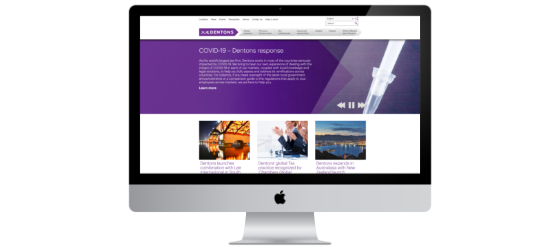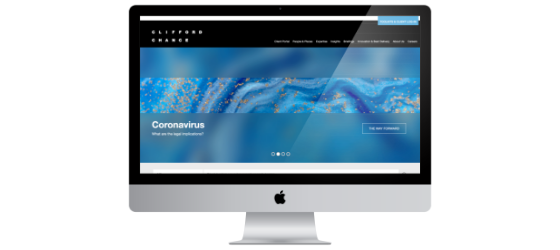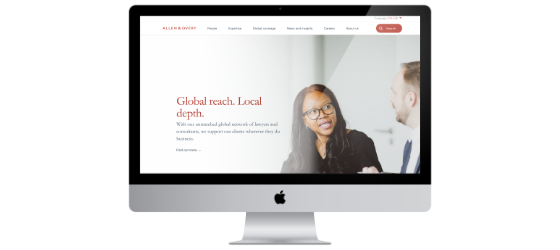AmLaw Global 50 Aggregate Scores
| # | Score | Description |
|---|---|---|
| 1 | 76.9 | Content is visitor focused (not "all about me") and is available in multiple languages |
| 2 | 88.7 | Page content has a clear information hierarchy and is well-organized for today's scanning reader (i.e., users subheads bullet lists, containers and boxes, etc.) |
| 3 | 84.6 | Practices and industries are broken out separately - by services that clients buy. Geographic regions is a bonus. Extra credit if firm uses captioned photos or other images to support and illustrate its industry or practice group content |
| 4 | 83.3 | Service descriptions include experience specifics, including client locations, names or alias descriptions of clients (answering the questions: what have you done, for whom have you done it and where?) |
| 5 | 51.4 | Video and multimedia content is featured, produced well and short |
| 6 | 89.4 | Landing page for news/articles/events, etc. is well organized and easily sorted by topic, author, date. Nothing is listed that isn't linked to a details page. |
| 7 | 81.3 | The site has a statement of core values that relate to clients, the profession and the market the firm serves |
| 8 | 95.5 | The highlights the firm's commitment to diversity and inclusion |
| 9 | 82.0 | Charitable and civic commitment is described and evident. Does it highlight the leadership shown by the firm and its lawyers? |
| 10 | 96.2 | Pro bono commitment is described in detail, highlighting stories and specific matters |
| 11 | 30.0 | Sites have a statement relating to the Modern Slavery Act |
Top Trends + Insights
The attributes in FBP5 - Content (other than biographies) have been slightly updated since the 2016 Study. The only new attribute is #11 "regarding including a statement relating to the Modern Slavery Act."
The total score of all 11 attributes on FBP5 - Content (other than biographies) in 2019 was 83.0 (“good”) – up just a hair from the 2016 total of 81.2. The lowest score in our latest Study was 61.0 (“fair”).
Only one law firm scored 100.0 on the first attribute with a visitor-focused eye to its content – Eversheds Sutherland US. The 2019 average score for the Global 50 firms on this attribute decreased to 76.9 (“good”) over the 80 received in the 2016 Study. Advice: Your content is more engaging and interesting if it’s not always about you. Eversheds Sutherland US also ranked #1 on FBP5 - Content (other than biographies). Congratulations!
Seven Global 50 firms scored 100.0 on attribute #2, "Page content has a clear information hierarchy and is well-organized for today's scanning reader (i.e., uses subheads, bullet lists, containers and boxes, etc.)."The average 2019 score of the Global 50 firms was essentially the same as it was in 2016.
- Why should law firm lawyers and marketers care about information hierarchy? Based on the analytics that we track, visitors are spending less time today on law firm websites than in 2016. Here’s how this breaks down: 1) their overall “dwell time” is less, meaning fewer total minutes per person; 2) they are spending less time than ever consuming practice and industry pages and 3) are consuming fewer pages per visit than our analytics showed in 2016.
- We analyze the information hierarchy of content and pages in several sections of the Ten Foundational Best Practices – it’s that important. To learn more about how you can succeed at it, read more in FBP2 - Design, FBP4 - Professionals’ Bios, FBP8 - Site Optimization + Online Awareness and FBP9 - Mobility.
Visitors are enormously distracted – even the ones who know you and really like you. You must make it easy to scan your pages on desktops, laptops, tablets, and phones (they don’t read). Make them more snackable and consumable. Design your pages more like a magazine with containers, boxes, callouts, snippets of information, infographics, and interesting headers and fonts to make your content visually enticing and more memorable.
Attribute #4, which focuses on "service descriptions include experience specifics", is another critical attribute and we mention this throughout the Foundational Best Practices.
- Think of your experience as the first currency you have as a lawyer and firm. It really is what makes your firm distinctive: you handle a specific issue with particular subject-matter variables for a certain person and client organization in a unique way in a domestic or foreign jurisdiction. No other firm will handle this matter in precisely the same way. New prospects must be able to evaluate you based on your experience – this is the “short-list test” about which we’ve written throughout this White Paper.
- If your major competitors are offering rich experience on their websites and you aren’t, your firm is at a distinct disadvantage.
- Read more about the importance of including specific and detailed experience on your website in FBP7 - Site Search and FBP4 - Professionals’ Bios.
- Finally, because experience is such a table-stakes component of practice and industry descriptions (and lawyer bios, of course), we invite you to visit the sites of the ten firms that scored 100.0 on attribute #4: Dentons, Hogan Lovells, Jones Day, King & Spalding, Paul Hastings, Akin Gump, Winston & Strawn, Orrick, Covington and McDermott Will & Emery. Several other firms scored between 80 and 90, so firms are getting more conscientious about this. The lowest score was a 60.0 (“fair”).
We also track video and multimedia content in more than FBP5 — under FBP6 - Interactivity, Engagement + Social Outreach – so read more there. In 2016, the Global 50 firms scored 34.0 (“poor”) and in the 2019 Study, scored 51.4 (barely “fair”).
Even for the firms that feature a lot of video content, the researchers noted that some of it is overly platitudinous and, sadly, sounds too similar from firm to firm. We noted in FBP1 - Communicating your Message, that two themes were over-used in video: 1) the one-firm firm platform and 2) local roots/global reach – or about two dozen derivations of that. Dig deeper/work harder to unearth the essence of who your lawyers are and what firm leaders believe in before you script your video. You don’t want to look and sound like your competitor peer firms – or the money you are spending on video is just a waste of money.
In 2019, 15 firms scored “zero” on the video/multimedia attribute and ten firms scored 100.0.
Check your analytics: Do you want visitors to consume more of your news/articles/ publications/blogs, etc. content? Then seriously rethink how you organize and present that content.
- Visitors want one place they can go to find it all. Don’t separate news from events from alerts from blogs in your global navigation. The analytics prove visitors will not go to multiple locations to find relevant resources, etc. Call it Resources, Thought Leadership, Our Thinking, or Insights (for example) and include all of your smart thinking and events under that one umbrella.
- Once on that landing page, then you can offer special search functionality by topic, author, date, and type of resource (e.g., event, article, blog post, podcast). This enables visitors to choose a certain category of content and dig deep into that format type. We said earlier that visitors care more about the subject matter and less about format type. This page is the only place visitors may care. Or, they can search by subject matter and consume all you’ve published about that one topic.
- The landing page itself should have all the content feeding to it chronologically regardless of whether it is an event or an e-alert. Visitors don’t typically care what type of news item it is – they are simply seeking the latest information about, for example in Q1 2020, the coronavirus/COVID-19.
- Nearly every Global 50 law firm (and most other firms, too) organizes the landing page by the category of content that it is. This is the old-fashioned way of organizing news. For inspiration, visit cnn.com, wsj.com, or knowledge@wharton.com. There will be lawyers that find these sites messy and nerve-wracking, but if you want more of your content consumed, design your page like a popular news site and organize your offerings the way they do.
When it comes to corporate social responsibility (CSR) and attributes #s 7, 8, 9 and 10, the AmLaw Global 50 firms perform well. These attributes are about giving back and being good corporate citizens of the world. These sections of their websites often include heartwarming, life-changing stories that global citizens want to hear. Please share these impactful stories!
Attribute #7, including core values, actually went down from the 2016 Study – it was 92 (“excellent”) then and is 81.2 (“good”) now. We assume that most law firms of any size have core values, which are the fundamental beliefs of the organization. Putting this stake in the ground about who you are and how you operate helps future clients and employees determine if their values align with yours. This perceived alignment can shortcut the pathway to trust.
With an average score of 95.5 (“excellent”) in, 2019, attribute #8 ("the site highlights firm commitment about diversity and inclusion") firms are doing a fine job here – but all firms should score 100.0 on this. The lowest score was 70.0 (“fair”) and two firms received this because the content was buried too low on an ABOUT page or it was simply one non-specific statement.
Here are three examples of superior diversity and inclusion sections of websites that scored 100.0: Kirkland & Ellis is a leader in countless areas and diversity and inclusion doesn’t take a backseat to any of it. From its “Diversity Leadership Series” to the hundreds of IL and 2L fellowships they sponsor to their national awards and inclusive programming they offer, firms needing guidance here should view Kirkland & Ellis’s commitment as the gold standard.
The magazine-style layout of Goodwin presents numerous things to view, from its initiatives to its affinity groups to news to what “belonging” means.
And Clifford Chance is notable because the firm offers sub-navigation tabs within its Inclusion & Diversity page that more comprehensively defines what they are doing: Disability, Ethnicity, Faith, Gender, LGBT+, and Wellbeing. In case you are wondering what “Wellbeing” includes, the page starts with this: “At Clifford Chance we believe everyone is entitled to the same equality of opportunity and experience. Each of us can face a range of personal, work, and societal pressures that can impact our mental health and well being.” The firm features its programs, such as Work-Life Balance and Movember.
Attribute #9 ("charitable and civic commitment is described and lawyers’ involvement is noted") went down from the 2016 Study from 86.0 (“excellent”) to 82.0 (“good”). 14 firms scored 100.0, several scored 80 and above, but several firms scored 50 or below and two firms scored zero.
We want to highlight Proskauer’s global navigation because they include a section called “For Good,” which includes Pro Bono, Corporate Social Responsibility and a link to the For Good Blog. This blog features terrific posts covering topics such as mental health, the Equal Rights Amendment, grassroots activism for immigrant justice, legal access for rural Americans and numerous other socially relevant topics.
Pro Bono, attribute #10 is often one of the more interesting sections of a global firm website if lawyers do a good job of capturing and retelling these important stories. Of course, high profile pro bono matters also garner a lot of media attention and ultimately result in coveted industry and community awards.
- For pro bono, the Global 50 score in 2016 was 88.0 and it jumped up to 96.2 in 2019. 35 firms scored 100.0 on this attribute with the lowest scores being 80.0 (“good”). The content on these lower-scoring firms’ pro bono pages didn’t quite match the depth and breadth of the other firms that scored 100.0.
The final attribute, #11, was new in the 2019 Study even though the law that first addressed it was enacted in 2015. Until this Q4-2019 analysis of the Global 50, we did not notice any law firm policies relating to the UK Modern Slavery Act or Australia’s Modern Slavery Act of 2018.
- 15 Global 50 firms have a statement on their websites, with links to them often found in the footer. Several firms have posted articles discussing it but don’t include an actual policy on their websites. A couple of others include a link or statement on their United Kingdom location pages. A notably good example is Arnold & Porter, which links to a four-page PDF that clearly and completely outlines firm policy.
- Another excellent example is Norton Rose Fulbright, where the firm outlines the many aspects of inclusive firm policy and includes Key Performance Indicators (KPIs) for the years 2018, 2019 and 2020. Impressive that they established KPIs, are tracking how they are doing, and are openly posting how they are measuring their progress.
One of the finest examples of an EDI policy was written by a nonprofit, Dallas Theater Center, a Tony-award-winning LORT regional theater. We are including it in this White Paper because it identifies and defines the “equity” piece, which few law firms address. If you aren’t adding EQUITY to your D&I statements and policies, we encourage you to take that step.
Standout Firms
Dentons
This firm stands out because of the visitor focus of its practice and industry descriptions. In most or all instances, the first paragraph of the overview sets the stage about the subject matter in terms of issues, challenges, and opportunities. Dentons establishes a point of view and then describes why it is the firm to hire to address what’s ahead. The experience bullets for each description are very detailed and paint a solid picture of lawyer and team capabilities. Bravo!
Clifford Chance
If you want a terrific example of how to present firm innovation on a website (or just want to see what BigLaw is doing), view the “Innovation & Best Delivery” global navigation section. You might wonder what “best delivery” is, as we did: Clifford Chance defines it as “smarter ways of working.” Among the things they feature are three visitor/results-focused case studies that quickly summarize the benefits to the clients: 1) Employment law - Machine learning software reduces lawyer effort by more than 50% and speeds up delivery to the client; 2) Loan portfolio - Machine learning software reduces lawyer effort by more than 50% and speeds up delivery to the client; and 3) Due diligence - Machine learning software reduces lawyer effort by more than 50% and speeds up delivery to the client.
Allen & Overy
Americans who work in the legal industry are used to what now seems ubiquitous – the American Lawyer (AmLaw) 100 and 200 financial reviews of self-reported law firm revenues and profits. But we have never seen a law firm publish its own audited financial statements as Allen & Overy has, making what it presented to its partners available for all website visitors to see. Smartly, they take the opportunity to highlight firm strategy, firm innovation advancements, firm governance structure, how they manage risk and compliance, and much more. It feels transparent and remarkable.
Simpson Thacher
The firm was also called out in our 2016 Study. Watch Simpson Thacher’s videos as examples of beautifully-produced, artfully- scripted, and carefully-messaged content. The history video is long but worth watching the eight-plus minutes that tell the story of the firm’s beginnings and how it grew into one of the most formidable law firms in New York – and beyond. Another favorite video is one that features highly diverse associates (plus a few partners) speaking about the summer program and how much they got out of it.
King & Spalding
This is another firm noted as “standout” in the 2016 Study. Their core values are the antithesis of platitudinous (a complaint we noted above). They are practical, walk-the-talk examples of what clients can expect when they hire King & Spalding lawyers to represent them. For example, here are a few: “demonstrate a can-do attitude; speak business not legalese; solve problems, don’t just spot issues; walk in our clients’ shoes; enjoy the relationship and always take an uncompromising approach to quality.” The short, two-plus minute video highlights the core values and offers testimonial-style quotes from clients that prove the core-value claims they are making. Smart.
Akin Gump
The landing pages for all the firm’s major regions, practice and industry areas are especially interesting and engaging because the content and design work so well together. They are designed almost as “portals” to that subject matter, displaying, for example, a very short overview, links to all the sub-practice/industry pages, a simple infographic or two, an image of a downloadable PDF brochure, featured news and publications, related practices/industries/regions and the team. This content and design structure enables visitors to quickly scan all the offerings and then choose the one or two items that most interest them. We haven’t seen the analytics for these pages, but we are betting on a higher click-through rate than practice pages typically receive.
Do's
| Do name client-organization names in your representative experience when you have permission to do so. Use a descriptive alias when you don’t have permission. | |
| Do ensure that your site’s content is truly geared to the people who can hire you, and that it describes and illustrates benefits to them. | |
| Do create a logical information hierarchy to your content in all sections of the site. What is most important? What’s next most important? Use H-tags to help guide your human and bot visitors. | |
| Do take inspiration from today’s print magazines (Harvard Business Review is a great example) for page layout. People of all generations don’t read (they scan) – they’re seeking bits of information they can quickly consume. Organize your pages with subheads, bullet lists, boxes, containers, etc. | |
| Do step up your use of arresting imagery to add depth to all areas of your site. High-quality images grab your visitors’ attention; then, studies show, the next place their eye stops is on the caption (and message) that is linked to the image. Ensure that images boost your story, not detract from it. | |
| And along those lines, do identify a clear and consistent image style for your website. Multiple formats, combining illustrations and photos without clear design direction, mixing black and white photos with color images can result in a jarring, jumbled, messy experience for your visitor. Go one step further and build an image library that you will use on your site and in collateral pieces. | |
| Do understand how you pass the “short-list test” – include experience specifics in all service descriptions. | |
| Answer the questions: what have you done, for whom have you done it and what can you do for me? Don’t forget to also answer this: How will you do it? | |
| Do blow up your landing page for your News/Events/Resources section and pattern it after major news sites. Organize it chronologically so visitors can quickly scan ALL your news at once. Write compelling, evocative headlines that captivate your visitors and choose images that boost your story. | |
| Do highlight your firm and lawyer leadership when describing charitable, civic and professional commitments and associations. Link to every organization you support (great for SEO and helpful to these charities). | |
| Do describe pro bono matters in detail, with specific stories, outcomes and links to associated lawyers and practice groups (to the extent your bar rules allow). | |
| Do regularly clean house in your News/Events/Resources section and eliminate (or archive) news and events that are older than three years. For articles/publications, if they are seminal, five years is OK, but any older deteriorates the relevance of visitors’ site searches. |
Don'ts
| Don‘t make claims you can’t or won’t prove. Don’t write a laundry list of things you do in your various service areas without backing those up with proof – that is, detail your current and relevant experience. | |
| Lawyers: If you don’t have adequate detailed experience to qualify you as experts in a service area, don’t include that service area as a website page. You can mention your capabilities in your bio, but without enough specific experience, you shouldn’t build a page under services/industries. Doing this potentially breaches trust and dilutes the impact of your strongest and most influential practices. | |
| Don’t list any news, event, article or publication that is not linked to a details page. Buyers of legal services want access to the articles that can make their lives easier – and that further qualify the lawyers as experts. A simple article title, publication and date that don’t link aren’t meaningful at all. |
FBP5 Total Scores
Top Ten Performers
4 firms tied for 10th place so we are including all of them here.







